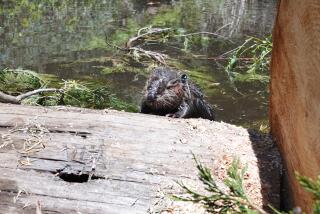‘Family Planning’ Spares Denver Trees
- Share via
DENVER — The patient getting her tubes tied on the operating table was pulled from a trap near the South Platte River that morning. Poking out from under the surgical cloth was her flat paddle of a tail.
At the other end, beneath the anesthesia mask, were twin 2-inch orange incisors. It took veterinarian David Robinson an hour of donated time to give the 48-pound beaver a tubal ligation and hysterectomy.
Her mate then was carried in for a vasectomy.
“If you don’t plan for wildlife in urban areas it becomes a nuisance,” says wildlife activist Sherry Tippie, who initiated the sterilization program in response to what city officials say is a gnawing problem--the rodents’ appetite for city trees.
To make a dent in their numbers, several beavers were caught and given contraceptive surgery under the experimental program run by the Colorado Division of Wildlife, the University of Northern Colorado and the citizens’ group Wildlife 2000, which Tippie heads.
If caught, a dozen more beavers will get the same treatment, and some will get contraceptive implants that release anti-fertility hormones over time.
It’s one of the first times contraception has been tried in urban-wildlife management, organizers say.
The large rodents live among the factories, rail yards and highways along the South Platte River. Strollers and cyclists along a bike trail there were stunned to see program volunteers hoist the caged beavers--one as heavy as 60 pounds--out of the water.
But along the water’s edge are piles of branches and sticks beavers build as lodges and food caches, and also the occasional conical stump with tell-tale tooth marks.
Beavers caused an estimated $100,000 damage to trees along Denver’s rivers and creeks last year, said city parks spokeswoman Amy Pulver.
“Having urban wildlife is an amenity. People go to see it, children can learn from it,” she said. “But trees are an amenity too. We’re trying to find a balance.”
An ordinance passed several years ago outlaws trapping as too dangerous, and besides, says Tippie: “The general public doesn’t want animals killed.”
Her answer: a combination of relocation and family planning.
The animals, whose valuable pelts lured some of the first whites to Colorado, were virtually annihilated last century to satisfy demand in eastern and European cities for beaver hats.
In recent decades, the beaver population along the South Platte and its tributaries has rebounded, turning the waterways into “beaver highways,” said Mark Lamb of the state wildlife division. He estimates that within Denver alone there are about 75 beavers.
Decades of development, however, reduced the scrubby vegetation and cottonwood trees along the river. Sometimes those trees were replaced with more expensive varieties.
The beavers gnaw what they find.
Tippie, who is “nuts about beavers,” offered to fix the city’s problem by fixing the beavers.
This summer, she, Lamb and a handful of volunteers, including a professional trapper, caught 46 beavers, from Evergreen in the mountains west of Denver to just south of Greeley on the northeastern plains.
At a cost to Denver of $75 per beaver, they relocated them to Rocky Mountain National Park, Fairplay, Glenwood Springs and other public and private sites where residents were interested in reintroducing beavers.
But relocation alone would not reduce Denver’s beaver population. If a pair is removed, another will take its place. Beavers are monogamous and territorial and will keep the population down on their own if they aren’t moved, the two say.
“The whole idea of contraception is that males being very territorial, once they’re sterilized they will also prevent fertile males from moving in. We’re using wildlife to manage wildlife,” says Tippie.
The sterilization program costs the city nothing. Robinson donates his time as a member of Wildlife 2000.
He performs tubal ligations and vasectomies rather than neutering the animals so they will continue to function as mates and families, only unable to reproduce.
Robinson puts a transmitter into each beaver’s abdomen so that Lamb can track their recovery and any subsequent migrations. The division and University if North Colorado biology professor Jim Fitzgerald in Greeley will monitor the program’s effects on the South Platte’s beaver population.
More to Read
Sign up for Essential California
The most important California stories and recommendations in your inbox every morning.
You may occasionally receive promotional content from the Los Angeles Times.













